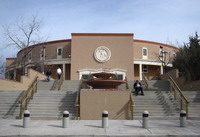Login form
New Mexico

New Mexico is nicknamed the Land of Enchantment for its magnificent scenery. The scenery includes snowcapped mountains, desert landscapes, steep canyons, and colorful rock formations. The state’s beauty enchants, or delights, visitors and residents alike.
NEW MEXICO’S PEOPLE
New Mexico is proud of the three cultures that make up its heritage—Hispanic (Spanish-speaking), Native American, and Anglo (English-speaking). Today, about 42 percent of New Mexicans are Hispanic, and nearly 10 percent are Native Americans. The Navajo, Pueblo, and Apache are the largest Native American groups in the state.
|
Facts About New Mexico |
|
|
|
|
|
Capital |
Santa Fe |
|
Population |
1,870,000 people |
|
Rank among states in population |
36th |
|
Major cities |
Albuquerque, Las Cruces, Santa Fe |
|
Area |
122,000 square miles |
|
Rank among states in area |
5th |
|
Statehood |
January 6, 1912, the 47th state |
|
State nickname |
Land of Enchantment |
|
Name for residents |
New Mexicans |
|
State bird |
Roadrunner |
|
State flower |
Yucca |
|
State tree |
Nut Pine |
|
Abbreviation |
NM |
EXPLORATION AND STATEHOOD
New Mexico lies just north of Mexico. The region got the Spanish name Nuevo Mexico (New Mexico) in the 1500s from Spanish explorers. Native Americans told the explorers tales of a wealthy kingdom, the Seven Cities of Cíbola. These legendary Native American cities were said to be full of gold.
In 1540, Francisco de Coronado headed an expedition to claim the cities for Spain. He found Cíbola in what is now New Mexico. It was a cluster of stone and adobe dwellings of the Zuni people. But Cíbola contained no fabulous riches, and Coronado left disappointed.
The first Europeans to settle in New Mexico also were Spanish. The New Mexico region had little contact with the United States until the Santa Fe Trail opened in 1821. The trail ran from New Mexico to Missouri. It remained in use until the railroad replaced it in 1880.
New Mexico became part of the United States in 1848 after the Mexican War. On January 6, 1912, New Mexico became the 47th state. Santa Fe was its capital.
SANTA FE
Santa Fe is one of the oldest European settlements in America. Spanish colonists founded it in 1610, ten years before the Pilgrims landed at Plymouth. It became the capital of Spanish territory north of Mexico. Today, many of the city’s buildings are in the Spanish colonial style. Low and flat-roofed, they are made of sun-dried brick called adobe.
Santa Fe grew because of two famous trails. El Camino Real led from Mexico City to Santa Fe. From the 1600s on, Spanish explorers, colonists, and traders used this road. In the 1800s, the Santa Fe Trail became a trading route and wagon-train route for settlers.
Santa Fe’s bright sunshine and beautiful desert scenery have long attracted artists. American artist Georgia O’Keeffe fell in love with the area on a visit in 1929 and moved there in 1949. One of Santa Fe’s many museums exhibits her work. Visitors to Santa Fe can admire and buy Spanish colonial art and Native American art at annual fairs.
TAOS
Taos, a town in northern New Mexico, was founded as a Spanish trading post in 1615. Like Santa Fe, Taos attracts artists and tourists. In winter, people come to ski. One of the town’s best-known residents was frontiersman Kit Carson. His house is now a museum.
An ancient Native American village, the Taos Pueblo, is a major attraction in Taos. It has been occupied for at least 800 years. Pueblo is a Spanish word for “village.” In a pueblo, adobe houses are stacked on top of each other, four or five stories high. People who live in a pueblo climb by ladder from one story to the next. Native Americans who live in a pueblo are also called Pueblos.
You can visit the Taos Pueblo and other pueblos nearby to learn about pueblo life. You may see Native American ceremonies, such as the corn, deer, or buffalo dances. You can also admire the pottery, jewelry, weaving, and other arts for which the Pueblo people are noted.
ALBUQUERQUE
Albuquerque is New Mexico’s largest city. It is located on the Rio Grande, the state’s major river. The Rio Grande flows across the state from north to south.
Every October, Albuquerque celebrates the International Balloon Fiesta. Hundreds of brightly colored hot-air balloons float in the sky.
CARLSBAD CAVERNS
Carlsbad Caverns National Park is in southeastern New Mexico. Carlsbad is one of the largest caves in the world. Miles of trails connect the cave’s chambers. In these chambers, pillars of limestone jut from the ceiling and the floor. Almost a million bats live in the cave. From May to September, they come out at night in search of insects to eat.
WHITE SANDS NATIONAL MONUMENT
Glistening dunes of white gypsum sand spread over 225 square miles (582 square kilometers) of southeastern New Mexico. The dunes form the White Sands National Monument, near Alamogordo. The gypsum comes from nearby mountains. Gypsum dissolves in water. Rainwater washes gypsum from the mountains and deposits it at the base of the mountains. When the water evaporates, it leaves the gypsum behind. Wind shapes the gypsum sand into dunes.
Near the White Sands National Monument, you can visit the White Sands Missile Range. The United States military tests rockets and missiles here. Missile systems are on display.
The first atomic bomb was exploded at Trinity Site on the White Sands Missile Range in 1945. From 1943 to 1945, during World War II, leading scientists worked at Los Alamos, New Mexico, on a top-secret project to develop the bomb. Today, scientists at the Los Alamos National Laboratory develop high-speed computers, lasers, weapons, and other high-tech items.
Source: Microsoft ® Encarta

